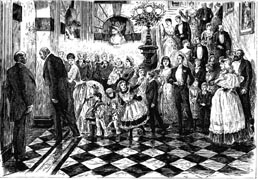The author has graciously shared with readers of the Victorian Web this passage from the second edition of her Fashion in Costume, 1200-2000 (2000), published by A & C Black (Publishers) Ltd., which retains copyright. Readers wishing to obtain of the complete book can e-mail the following address: sales@acblack.com .
 n the 1860s Charles Frederick Worth, an Englishman, became chief
dressmaker to the Empress Eugénie and was responsible
for raising the status of the dressmaker or dress designer, opening the
way for the eventual development of Parisian Haute Couture. Worth
survived the Siege of Paris in 1871, the Commune, civil war, and the
establishment of the new Republic, and the name Worth became synonymous
with Paris fashion. Wealthy American ladies from Boston, according to
Edith Wharton in The Age of Innocence, bought
their clothes from Worth but, being of a prudish nature, laid them down
like port to mellow, waiting two years before wearing them in public.
Although Worth had previously dismissed English women as parsimonious,
Lily Langtry bought seventeen trunks full of new dresses from him in
1881.
n the 1860s Charles Frederick Worth, an Englishman, became chief
dressmaker to the Empress Eugénie and was responsible
for raising the status of the dressmaker or dress designer, opening the
way for the eventual development of Parisian Haute Couture. Worth
survived the Siege of Paris in 1871, the Commune, civil war, and the
establishment of the new Republic, and the name Worth became synonymous
with Paris fashion. Wealthy American ladies from Boston, according to
Edith Wharton in The Age of Innocence, bought
their clothes from Worth but, being of a prudish nature, laid them down
like port to mellow, waiting two years before wearing them in public.
Although Worth had previously dismissed English women as parsimonious,
Lily Langtry bought seventeen trunks full of new dresses from him in
1881.
Wealthy and fashionable ladies deemed it necessary to have a different outfit for mornings at home, visiting, taking tea, dinner or garden parties, the opera or balls -- not to mention special gowns for weddings, presentation at court, and sporting costumes. The amount of time spent in changing their clothes during weekend parties at grand country houses must have been prodigious.
Two representations by George du Maurier of life at a grand country house: (left) Breakfast at Bonnebouche Hall; (right) Precedence at Bonnebouche Hall during the Holidays. [Click on images for larger plates and additional information.]
References
Nunn, Joan. Fashion in Costume, 1200-2000. 2nd edition. A & C Black (Publishers) Ltd; Chicago: New Amsterdam Books, 2000.
Last modified 22 August 2024

